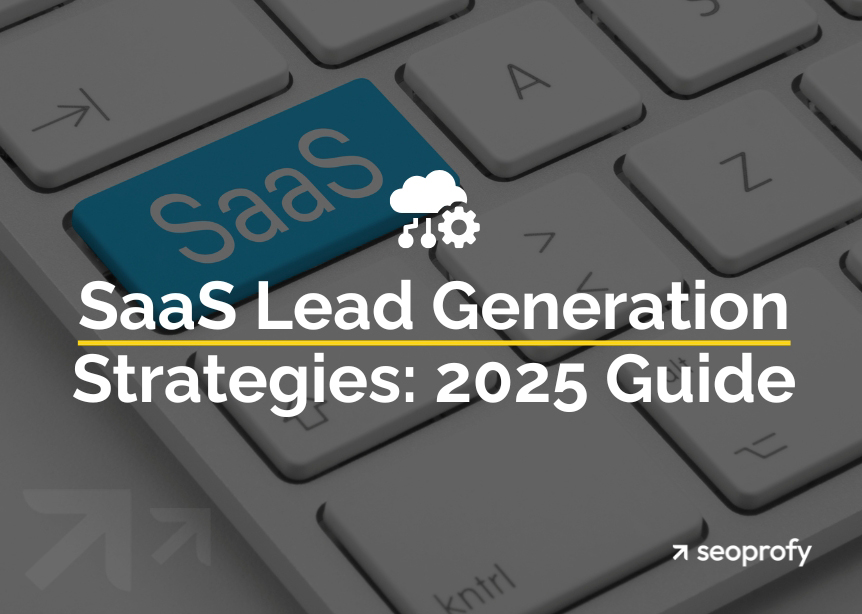Realistic SEO forecasting involves using real data and trends to get a clear picture of how your website is likely to perform in the future. It helps you set practical goals, justify your SEO budget, and make smarter strategic calls. By looking at past performance, keyword trends, and market changes, you can estimate future traffic, rankings, and conversions — and adjust your approach before issues arise.
This guide walks you through how to create realistic SEO forecasts using methods that actually work, tools you can trust, and data you already have. Use it to build a strong case for investment, plan your next quarter with confidence, and make smarter, data-driven decisions.
- SEO forecasting turns data into direction. It helps you predict traffic, rankings, and conversions using keyword trends, competitor data, and past performance — so you can plan, not guess.
- Forecasting supports smarter budgeting. When you tie predictions to ROI, you can justify SEO spend, prioritize high-impact actions, and align internal teams around realistic goals.
- No method is perfect. Each approach has limitations — from volatile search trends to limited historical data — so it’s crucial to cross-check and adapt regularly.
- Consistency and context matter. Your technical SEO health, resources, and market changes all influence how accurate your forecasts will be — and how well your strategy performs.
What is SEO Forecasting?
SEO forecasting is a way to predict future website performance and results of your SEO roadmap based on historical and current data. You can use it to estimate potential growth in website traffic, organic search results, revenue, and visibility. It helps to set realistic expectations, develop a more efficient strategy, and predict traffic patterns.
For reliable SEO projections, it’s better to review first-party data that refers to your website analytics, historical rankings, and conversion rates, with third-party data from platforms like Google Search Console, Ahrefs, or SEMrush. For example, these SEO tools can help identify future trends, click-through rates (CTR), and total search volumes in your niche. With these insights, you can improve your roadmap, investment planning, and expectations around results and SEO results timeline.
When done right, SEO projections support more confident budgeting, prioritization, and help you clarify your SEO ROI.
Why Your Website Needs SEO Forecasting?
Businesses that use SEO forecasting gain the ability to make smarter decisions, reduce guesswork, and stay competitive in search results. Predicting future performance based on real data allows marketers to make better-informed decisions and prioritize efforts that deliver results.
For example, e-commerce companies can perform SEO forecasting to predict seasonal spikes in search demand and optimize product pages. This can provide more conversions during peak shopping periods.
Sure, SEO forecasting is difficult because search algorithms, trends, and competition change frequently. When you build SEO strategy on proven data, your actions are more targeted, and your results are more predictable.
Here are some benefits that you can obtain from SEO forecasting:
- Setting realistic expectations for traffic and lead generation.
- Efficient allocation of marketing budgets.
- Content gaps or keyword opportunities identification.
- Tracking progress toward SEO goals.
- Justifying investment with projected SEO ROI.
To gain more insights, explore our SEO case studies for businesses.
3 Ways for SEO Forecasting
There are several methods of how to forecast SEO performance. You can use only one or combine all three to increase reliability and insight. The three main SEO forecasting techniques are keyword analysis, competitor and industry trends, and historical website performance. This SEO forecasting guide will walk you through these methods.
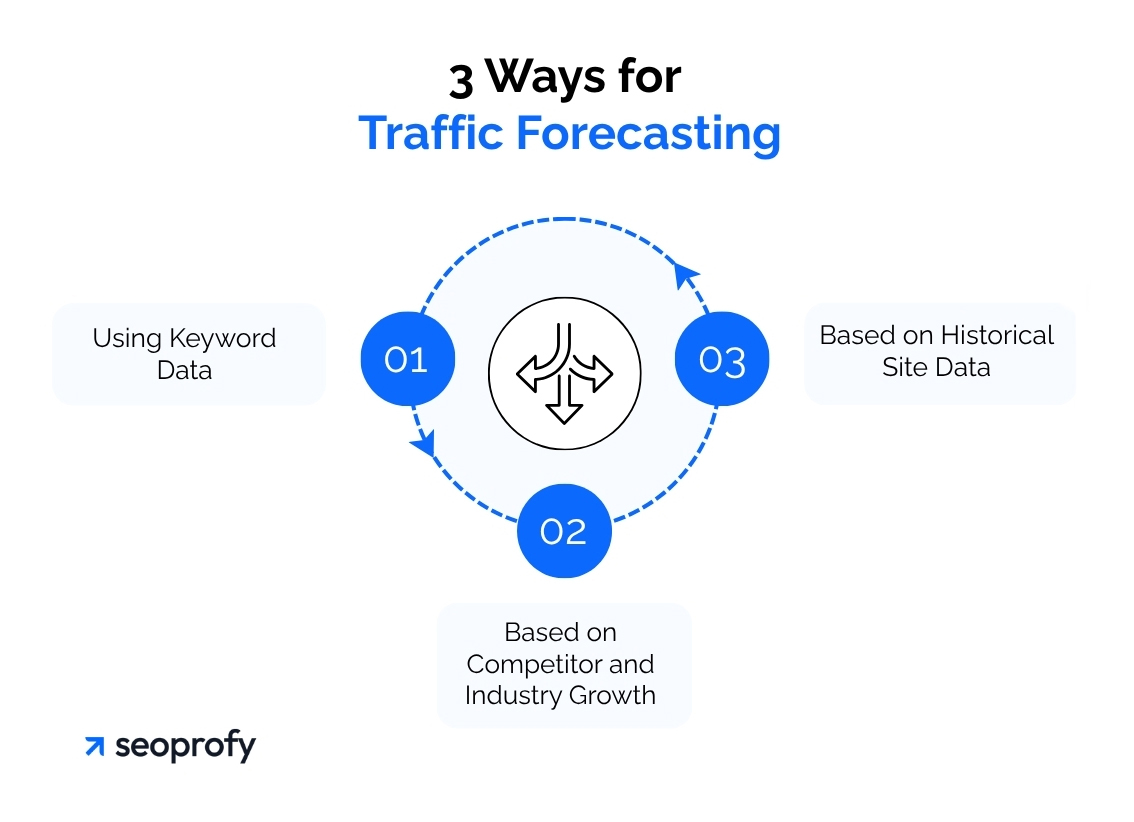
Each method of SEO projections has its own advantages and inaccuracies. For example, keyword-based models may miss changes in search behavior, and relying on historical data only may ignore shifts in algorithm updates. The combination of all approaches creates a more balanced and data-rich organic traffic forecast. If you have a startup and plan your first campaign or an established brand and refine your SEO roadmap, you can combine these SEO forecasting tips for more confidence and strategic focus.
1. Traffic Prediction Using Keyword Data
One of the most common SEO forecasting methods is keyword-based traffic prediction. It predicts the quantity of your website visitors by looking at target keywords. You only need to rank well for specific terms.
To start, you have to identify target keywords that people use to search for your and related services or products. The next step is to see how often each keyword is searched per month. Then, check how many clicks you might get if your website ranks well for target keywords.
With this info, you can estimate the organic traffic each keyword can bring. For that, multiply the monthly search volume of each keyword by the expected click-through rates (CTR) for a given ranking position. Recent SEO stats reveal that 54% of all clicks go to the first three Google search results, while only 0.44% of users venture to the second page. This data highlights the critical need for accurate keyword analysis in SEO traffic forecast to achieve top rankings.

The keyword forecasting method can help you to build an SEO roadmap, prioritize keywords with high traffic and conversion potential, track progress toward SEO performance milestones, and plan for short-term wins and long-term growth.
Main Tools to Help with This
Semrush, Ahrefs, and Google Search Console are among the most popular tools for obtaining reliable keyword research. With them, you can obtain valuable insights into historical traffic data, monthly search volume, CTR benchmarks, difficulty scores, and keyword rankings over time.
Ahrefs is best for in-depth keyword data, traffic potential, and competitive analytics. Its key features include keyword search volume, traffic estimations for competitors’ pages, and SEO forecasting tools. Semrush is mainly used as an all-in-one SEO suite with keyword and domain analytics. With functions such as traffic forecasting, competitor traffic data, and a keyword research tool for volume, trend, and search intent.
As for Google Search Console, you can use it to monitor and optimize your actual keyword performance to see which keywords already drive clicks and monitor trends to project future growth.
Regular use of these and additional SEO tools supports ongoing measurement and alignment of your SEO strategy with actual market dynamics. However, it requires consistent implementation and informed decision-making.
Cons of Predicting Traffic from Keywords
Keyword-based forecasting can also be a useful tool for SEO projections. But it isn’t foolproof. One of the major obstacles is the volatility of SEO trends. For example, a keyword’s search volume can spike or drop randomly due to seasonal shifts, news events, or algorithm updates. For example, in 2024, 24.2% of respondents claimed that Google’s algorithm updates helped their SEO a lot, while 9.5% noticed a drop.
Besides, CTRs are not static. A keyword might have a strong monthly search volume, but it can vary depending on its placement. In particular, a keyword beneath a video carousel may have lower traffic than expected.
The other cons you may face while forecasting SEO traffic with keyword analysis include:
- Unpredictable search behavior: Google algorithm updates, trends, and changes in user behavior can make projections inaccurate.
- Data limitations: Tools like Google Keyword Planner or Ahrefs offer estimates, not exact numbers.
- Competition: High-traffic keywords are usually highly competitive, meaning it may take months to rank.
- Overfocus on numbers: Relying too much on traffic numbers might lead you to ignore long-tail or niche keywords.
Boost the Precision of Your SEO Projections
To improve the accuracy of keyword-based SEO forecasting, you should use several tools and analyze trends and customer behavior. This can provide you with better results and a higher ranking.
Relying on just one tool can give you false numbers; instead, it’s better to cross-check keyword volume through several sources. While each tool has different sources and algorithms, cross-referencing reduces the risk of error. Also, remember click potential. Focusing only on search volume can lead to overestimating results. Not all searches result in clicks.
Factor in your current rank for each keyword and estimated CTR for that rank. Some keywords may have high potential that dips in off-seasons. For example, “bike accident lawyer” searches may drop in winter in colder regions. Thus, factor in seasonality and trends. You can use Google Trends to check if a keyword is seasonal and if search volume can grow or decline over time.
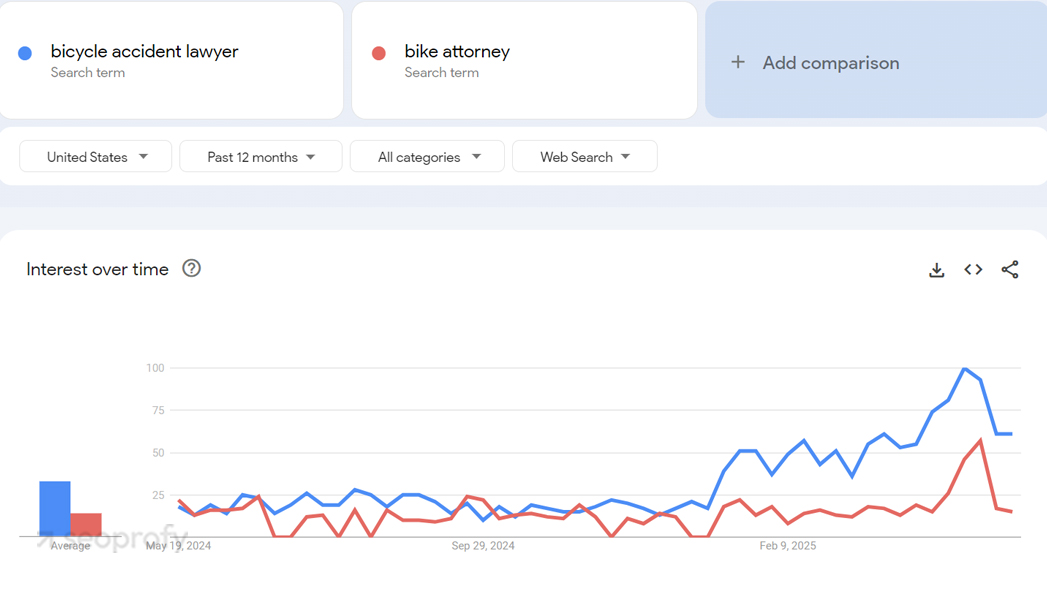
This approach lays the foundation for future SEO success and supports more confident investment in your SEO strategy.
2. Traffic Forecasting Based on Competitor and Industry Growth
Projecting through competitor and industry analysis is also an effective method of forecasting SEO traffic. This means you review competitors’ organic visibility, keyword usage, and content strategies as well as broader industry trends. It provides an understanding of other businesses’ positions in the market and what level of SEO performance you can aim for. This can be especially useful for newer sites or businesses with limited first-party data.
For example, you can estimate traffic based on your direct competitor’s ranking for a group of high-volume keywords. For that, you analyze how much traffic all the keywords can bring to other websites and then benchmark your site in terms of domain authority, backlink profile, and content depth. Here’s how to do SEO forecasting through competitors’ analysis:
- Pick 3-5 competitors: Choose those who are ranking for the same keywords or targeting the same audience.
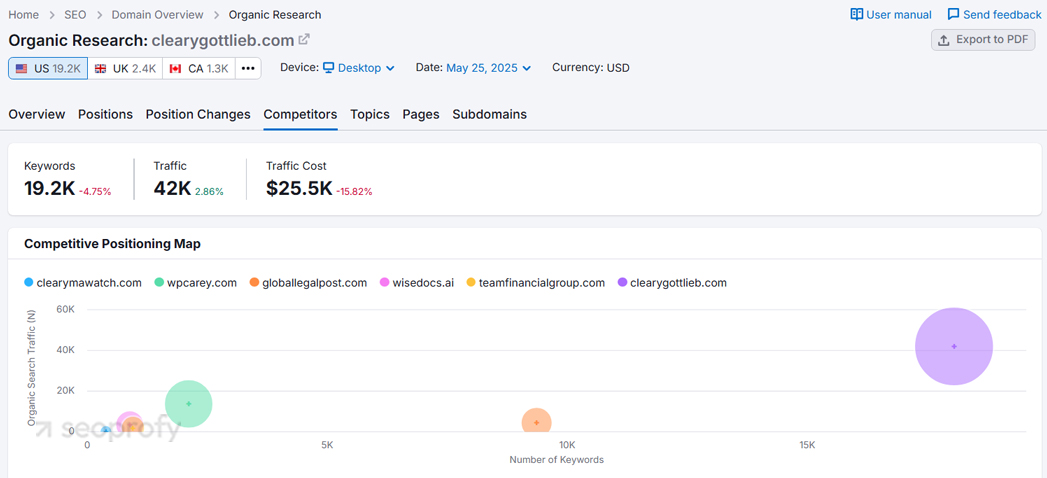
- Analyze their traffic trends: You can use SEMrush or Ahrefs to review monthly traffic trends, top-performing content, and ranking keywords.
- Compare with industry growth: Use Google Trends or niche reports to see if your sector is expanding or shrinking.
- Build a model: Estimate growth per month based on competitor or industry trendlines. Then, you can use it to adjust your domain authority, content output, and SEO investment.
Main Tools to Help with This
The main tools to build a competitor- and industry-based forecast like Ahrefs or SEMrush. These tools are ideal for building traffic projections grounded in actual market data. You can also view keyword search volume, keyword difficulty, and estimated traffic values for any domain, making it easier to predict future rankings and inform your projections.
Then, you can export competitor main keywords to Google Sheets and combine them with your input data for side-by-side comparison. This offers a clear picture of your progress and reveals where your efforts should be concentrated for better search engine optimization.
Cons of Predicting Traffic from Competitor and Industry Growth
Forecasting based on competitors can be tricky, as it comes with its uncertainties. The search engine landscape is constantly shifting amid Google algorithms, new businesses entering the space, changes in user behavior or needs, and updated SERP features.
These factors can impact your competitors’ visibility and your expectations as well. Thus, you should consider the evolving market as well, not only rely on a static snapshot of your competitors’ data.
Also, remember that past trends don’t always reflect future performance. If a company drops in search rankings, or if your industry sees a new surge in demand, your forecast SEO growth model may become outdated.
The other main challenges include:
- Blind spots in industry historical data. Some niches have limited search data, especially if they’re highly localized.
- Assumes you’ll surely repeat their success. Your resources, domain authority, or team may not match your competitor’s setup. The forecast should factor in your own constraints.
- The lag between industry growth and your results. Even if your industry is growing fast, it might take months before your SEO catches up, especially in competitive markets.
How to Make a More Accurate Forecast
Despite all the cons and challenges, you can improve the reliability of competitor-based forecasting, and now we’ll review how to do so. The main thing is to focus on long-term performance patterns, not just current trends.
For example, you should track competitor keyword rankings and search traffic over several months, monitor changes in their backlink profile, and analyze shifts in search volume across target keywords. These long-term signals provide more stable data for your traffic forecast insights and reduce the risk of reacting to spikes and dips.
To improve the accuracy of traffic forecasting based on competitor and industry growth, you need to combine data precision, contextual insight, and realistic modeling. Here’s how to do so:
- Choose the right competitors: Focus on direct SEO competitors, not just business rivals. By doing this, you prioritize sites of similar size or authority to yours to improve accuracy.
- Use multi-tool verification: Relying on one platform can be misleading. Thus, you should combine data sources to smooth out extreme highs or lows in the historical data.
- Adjust for your domain authority and resources: Just because a competitor grew 40% in 3 months doesn’t mean you will. With tools like Ahrefs Domain Rating, you can compare site strength. In addition, it may be useful to factor in your content output, budget, and link-building ability.
- Incorporate industry seasonality and trends: Industry-level growth may be seasonal or event-driven. Google Trends shows if search traffic rises or falls during certain months.
- Regularly update your predictions, as they are only as good as the last data input: Make it a habit to refresh competitor data monthly or quarterly and adjust the projection based on your actual performance.
Conducting research with realistic modeling and a focus on long-term performance patterns can help not only estimate the future organic traffic growth but also the effort your timeline requires for your results. It’s a practical approach for understanding potential growth, refining your SEO roadmap, and supporting your next investment in white-hat SEO.
3. Traffic Forecasting Based on Historical Site Data
The other reliable and grounded way of predicting SEO traffic is to analyze your website’s historical site data. This method reviews first-party data about past performance — organic traffic, conversion rate, keyword growth, and seasonality — to make educated projections. The main point is to define how much organic traffic growth occurred month-over-month or year-over-year. With this information, you can develop traffic models to determine what trends are likely to continue.
If you choose this method, you review data like monthly visits from organic search, historical keyword rankings, seasonal spikes or drops in website traffic, and conversion rates tied to SEO campaigns. In particular, you should:
- Export past performance information: You can gather data from the search console for impressions, clicks, and positions.
- Clean and segment: Once you pull all the necessary data, you need to break traffic into organic, paid, referral, and direct. In addition, segment the blog and landing pages for more reliable results.
- Choose a forecasting model: There are three common methods: linear growth, seasonal model, and exponential or logarithmic. Linear growth is usually used when traffic grows at a steady pace. The seasonal model uses a 12-month average and seasonal adjustments. This model is suitable if you have seasonal peaks or dips. As for exponential or logarithmic methods, it’s more appropriate when you’re scaling fast, as it reflects rapid initial growth that levels off.
- Create a forecast: Remember to update your projections regularly to reflect organic traffic, any changes to SEO or marketing strategy, or notes on anomalies.
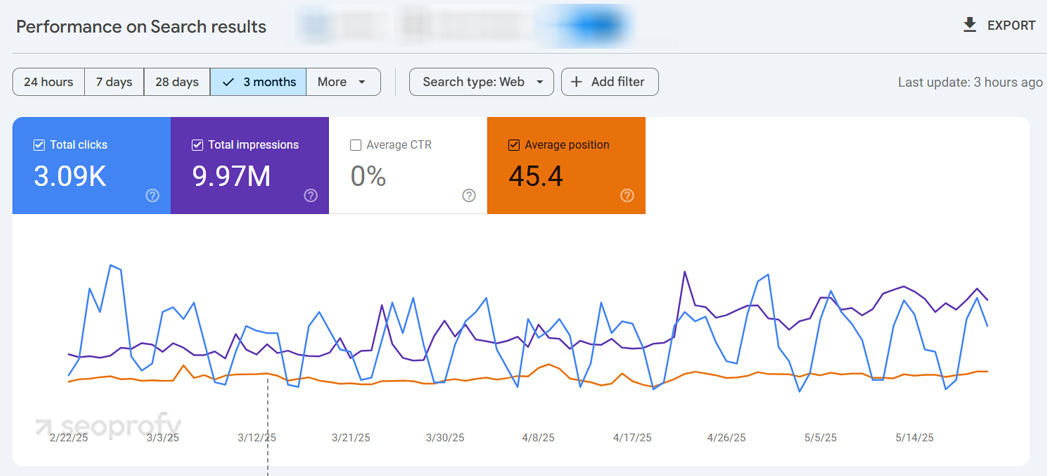
This type of forecasting is helpful for businesses with stable SEO efforts or consistent publishing schedules, such as e-commerce sites preparing for seasonal shopping trends. This model also supports more accurate results and timelines and allows you to track whether you’re on pace with your defined SEO goals.
Main Tools to Help with This
Several tools can help you collect and visualize the input data needed for this method. They provide insights on estimated monthly traffic, filter by time period, and analyze how fast SEO roadmap changes affect results. The most widely used and reliable are:
- Google Search Console: To monitor keyword impressions, CTRs, and rankings.
- Google Analytics 4 (GA4): To analyze organic traffic trends, user behavior, and conversions.
- SearchAnalytics: To consolidate data from multiple platforms and apply predictive analytics to generate an actionable model.
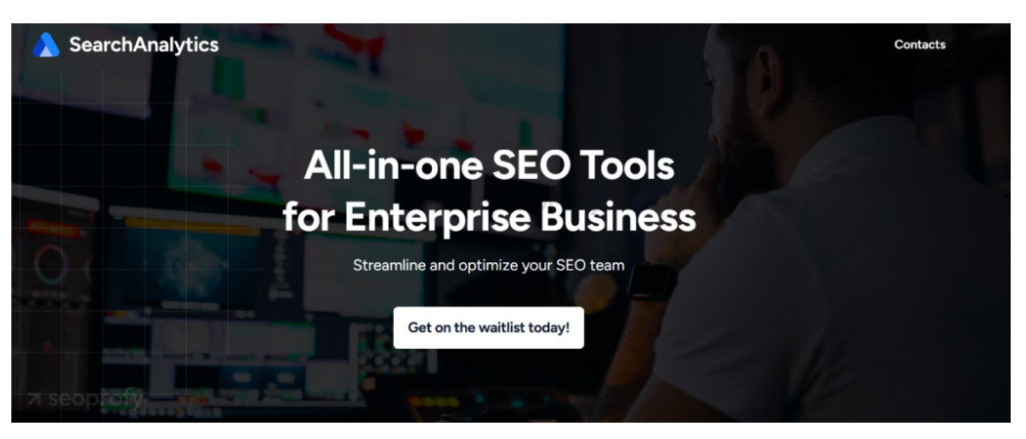
You can also use Google Sheets to build forecasting models (linear, compound, or seasonal). This helps visualize future website traffic patterns.
Using SEO audit services or working with a data-driven SEO company like SeoProfy can further refine these insights into more practical projections, especially when combined with competitor and industry data.
Cons of Predicting Traffic from Historical Site Data
Forecasting based on historical performance comes with a few key limitations. For example, Google Search Console stores data for up to 16 months. This can restrict long-term analysis unless you’ve been exporting and storing this data elsewhere. Without long-term visibility, it’s harder to capture multi-year SEO growth patterns or declines. In addition, the accuracy of historical models can be distorted by Google algorithm updates, website redesigns, changing use behavior, emerging trends, or shifts in search engine rankings.
Seasonality can also affect data. For example, monthly organic traffic may spike during holiday shopping periods or dip during off-seasons. If you don’t account for these fluctuations, you may obtain false projections.
The additional challenges you may face:
- Unstable or incomplete data: If your website is new or inconsistent in publishing, predictions can be unreliable.
- Ignores market shifts: Past performance won’t reflect changes like new competitors, Google algorithm updates, and emerging search trends.
- Doesn’t account for strategy changes: If you plan to double your content or start link building soon, projections based on previous trends may underestimate future growth.
Despite these challenges, the use of data based on historical data offers more stable starting points than third-party data estimates alone.
Enhancing the Reliability of Your Projections
To improve projecting accuracy when using historical site data, incorporate projected SEO performance trends within your industry. This helps evaluate if your organic traffic performance is changing with, ahead of, or behind the market.
Here’s what you can do to refine your expectations:
- Segment historical data by page, type, topic, or content category.
- Compare seasonal performance trends year-on-year.
- Identify patterns in keyword rankings over time.
- Cross-reference performance with competitor and industry data.
- Update for major SEO changes.
Remember to adjust projections if you launch a major campaign, gain or lose many backlinks, and migrate your site. This method gives you a clearer picture of your expected performance, supports better SEO ROI, and helps create a reliable roadmap.
Get clear answers about where your SEO stands and where it can take you next. Our audits and forecasts help you plan confidently and grow with purpose.
- Consistent organic traffic
- High-intent leads
- Stronger brand visibility
- Smarter SEO decisions

What Affects SEO Forecasting Accuracy
To predict SEO performance with confidence, you should understand what factors can affect it and how to account for them. Even with the most reliable tools, your projections will only be as reliable as the foundation they’re built on. The most essential components that can affect your SEO performance forecast are your technical setup and resource allocation.
Technical SEO
Before using any SEO forecasting tool or outlining projections, ensure your website is technically optimized. No matter how strong your keyword strategy or content calendar is, technical issues can block or delay results. A clean, crawlable, and optimized site is essential for Google to properly index and rank your content. For example, technical issues may include:
- Site speed and core web vitals: Slow or poorly performing pages reduce rankings, user retention, and conversion rates.
- Mobile optimization: Mobile-first indexing means mobile issues can tank performance.
- Broken pages or redirect errors: Loss of link equity and poor UX affect rankings and inflate bounce rate metrics.
- Site architecture and internal linking: Poor structure hinders keyword targeting and dilutes SEO value. You should also factor in such aspects as indexation health, canonical tags for duplicate content control, and structured data for enhanced SERP features.
Financial and Human Resources
SEO results depend on consistent execution, such as publishing content, acquiring backlinks, fixing issues, and optimizing performance. Without a dedicated team, budget, or clearly defined SEO strategy, your projections will remain theoretical. To forecast SEO growth, you must align your input with:
- Content budget: Determines how much new keyword-targeted content you can create to drive stable growth.
- Used SEO tools: Defines how well you can track, optimize, and review.
- Link building resources: Without time and money to build backlinks, your ability to rank new pages drops.
- In-house expertise: A weak team can’t implement technical fixes, content, or strategy consistently.
- Training and alignment: Marketing, dev, and leadership alignment is key to executing the SEO plan at scale.
Evaluating SEO ROI
Accurate SEO forecasting is not just about predicting website traffic. This is also about calculating the return on investment (ROI) for your SEO efforts. In short, it can be described by a question: “If we invest in SEO, how much will we get back?”
Before implementing your website growth strategy, you should conduct SEO ROI forecasting. You can do so by predicting organic traffic growth, assuming a conversion rate, reviewing average customer lifetime value, and evaluating investment in tools, services, and team. For a detailed guide on this process, check out how to calculate SEO ROI. You can also explore real-world data in SEO ROI statistics for better insights.
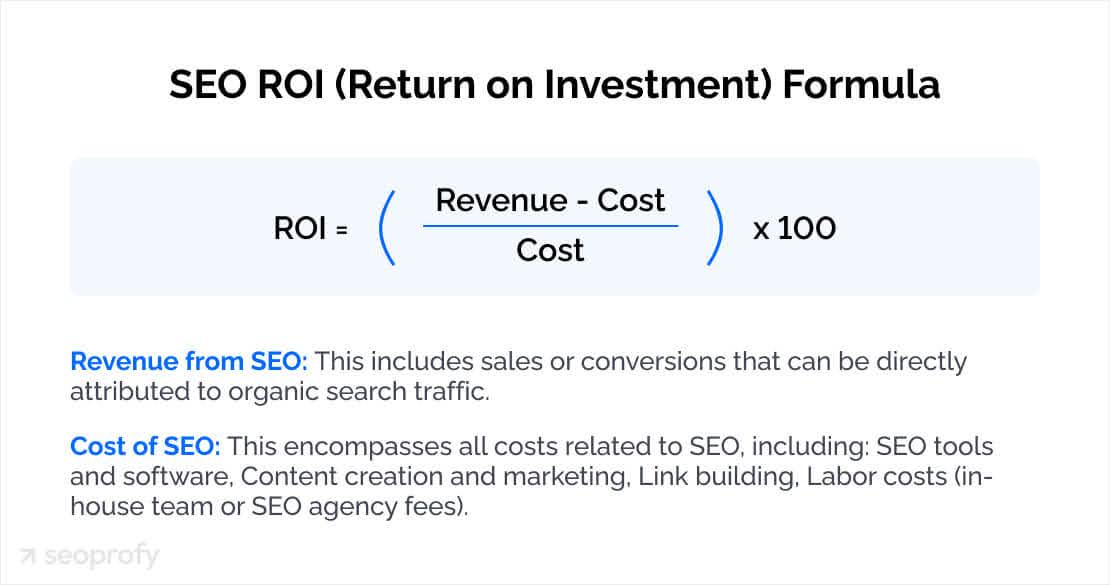
In particular, SEO ROI helps to:
- Justify the SEO budget to your boss, client, or finance team.
- To understand if SEO is worth the time and money.
- Prioritize SEO strategies that will bring the best return.
- Set realistic expectations before you invest heavily.
Without ROI forecasting, you’re guessing. This can lead to wasted money and missed opportunities. By anchoring your projections to dollars, you align your team, stakeholders, and expectations toward real outcomes. This is especially important when comparing traditional strategies with models like pay for performance SEO, which promise results but may overlook long-term growth potential.
Final Thoughts
SEO forecasting empowers you to make strategic decisions based on data, not assumptions. With the analysis of historical data, keyword trends, and competitor performance, you can ensure predictable growth patterns and align your SEO efforts with long-term business outcomes. In short, it turns guesswork into confident, data-driven planning.
If you want accurate projections and growth strategies backed by experience, partner with a data-driven SEO company. With SeoProfy, you can turn your organic traffic goals into projections you can count on.








